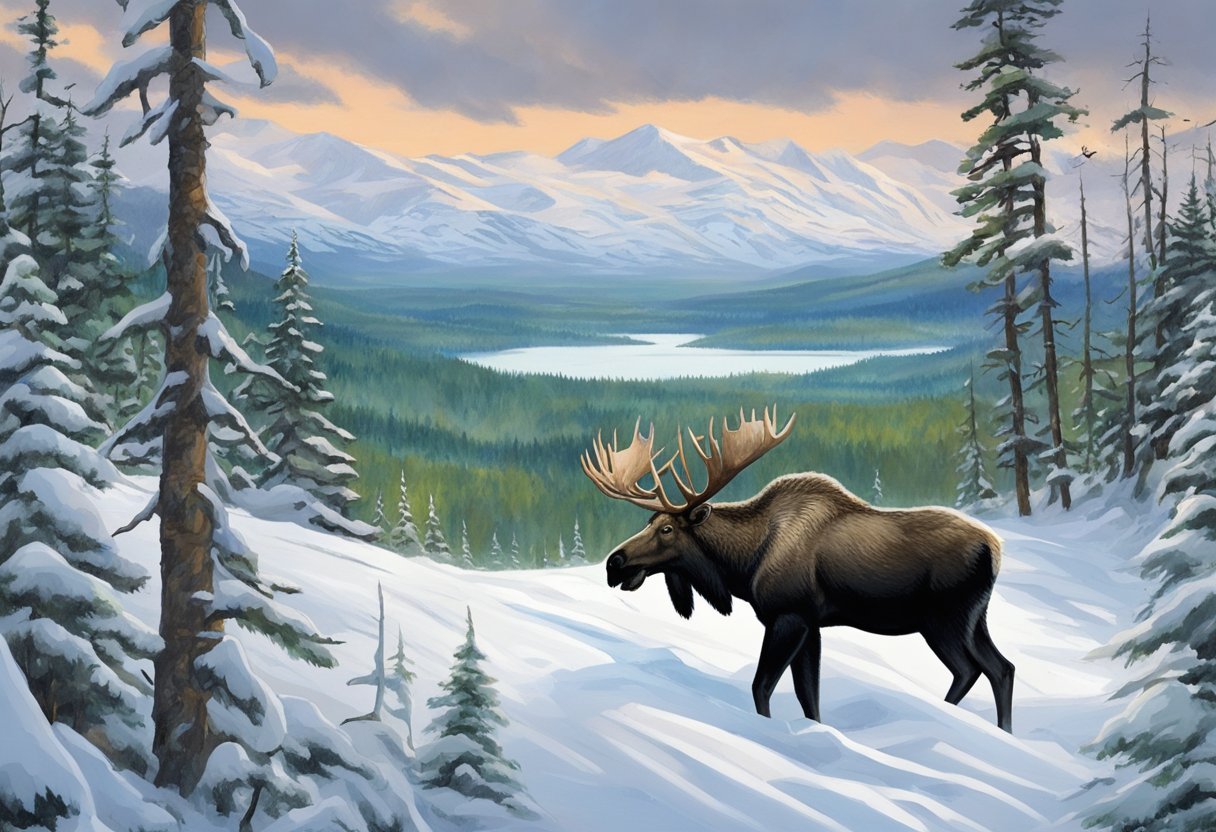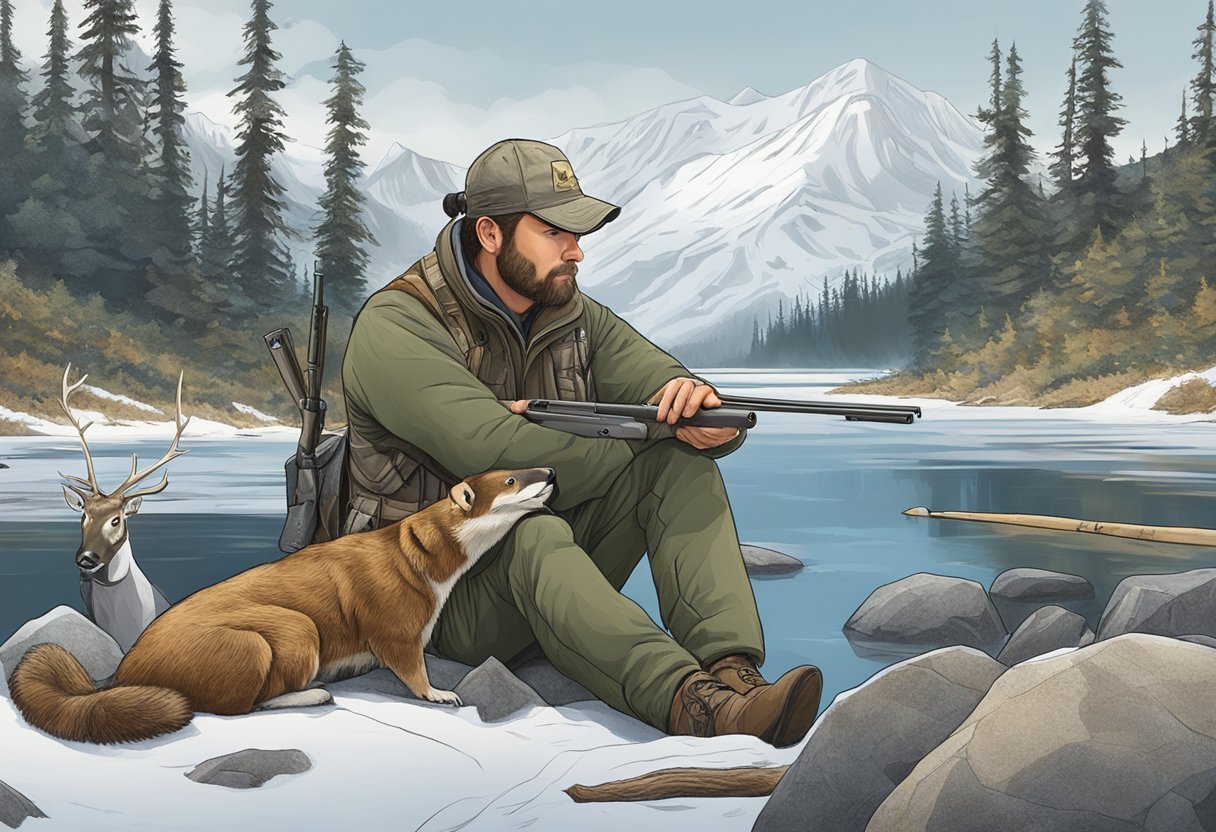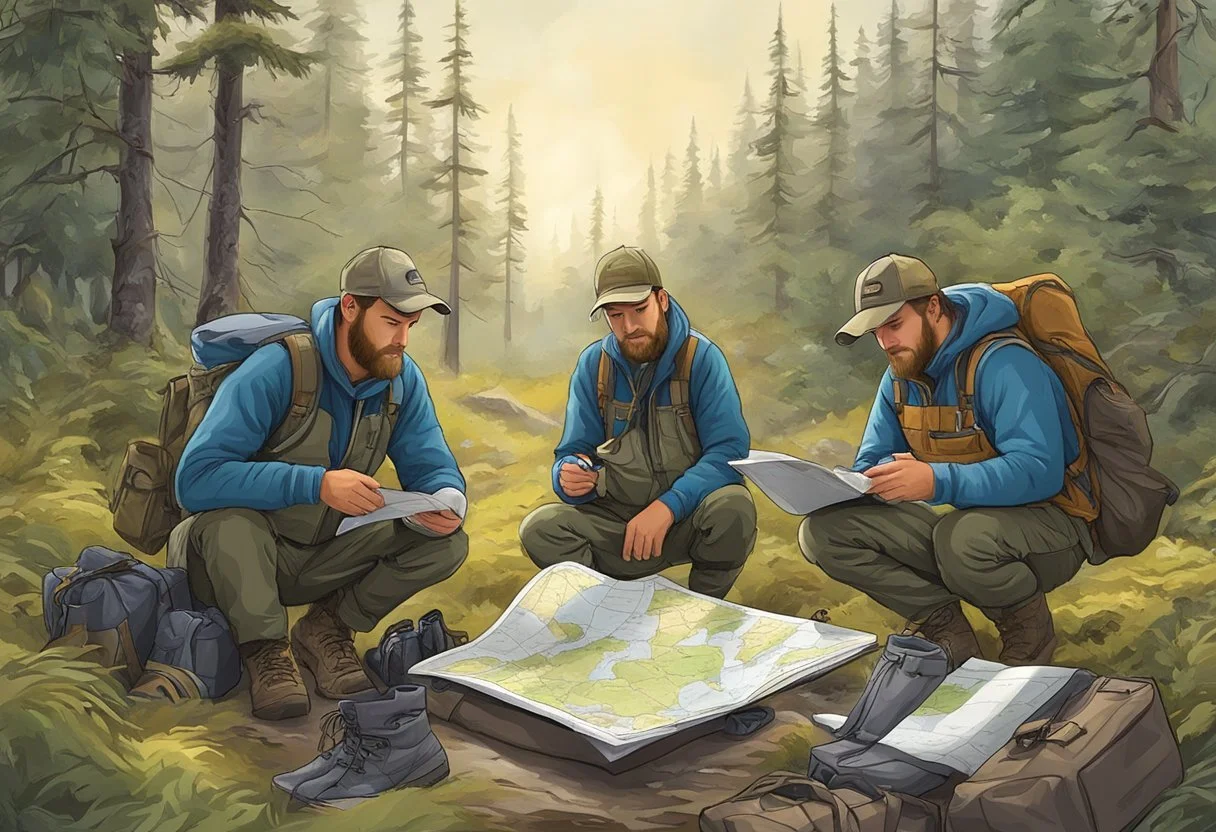Your Guide to Hunting in Alaska
Essential Tips and Tricks
This Article is Part of Our Hunting Guide for All 50 US-States
Embarking on a hunting adventure in Alaska is an exciting and rewarding experience for beginners and seasoned hunters alike. The Last Frontier offers a vast and diverse landscape teeming with wildlife, providing ample opportunities for novice hunters to sharpen their skills and challenge themselves in the great outdoors. However, as a beginner, it's essential to be well-prepared and knowledgeable about the terrain, regulations, and best hunting practices to ensure a safe and enjoyable experience.
Before setting off on your Alaskan hunting adventure, thorough planning and preparation are crucial. Understanding the state's hunting regulations, acquiring the appropriate permits and licenses, and familiarizing oneself with the local flora and fauna are all essential steps to take. Additionally, carefully selecting a suitable hunting area, acquiring suitable gear and clothing, and perhaps even considering a guided hunting trip may offer a more structured and educational experience for those new to hunting in Alaska's wilderness.
As with any new undertaking, gaining knowledge and experience will increase confidence and success. Alaska, with its vast expanse of wilderness, diverse wildlife, and breathtaking landscape, is the perfect backdrop to embark on a hunting journey. By taking the time to learn and prepare ahead of time, beginners will be well-equipped to face the challenges and thrill of hunting in Alaska, ultimately reaping the rewards of an unforgettable adventure.
Understanding Alaska's Hunting Regulations
Licenses and Permits
To hunt in Alaska, individuals need to obtain the proper licenses and permits. The Alaska Department of Fish and Game (ADFG) is responsible for providing hunters with the necessary documentation. Here is a list of the basic types of licenses:
Resident Hunting License
Nonresident Hunting License
Alien Hunting License
Additionally, there are specific permits and tags required for hunting certain species such as big game animals:
Big Game Tags (e.g., Moose, Caribou, Brown Bear, etc.)
Registration Permits
Drawing Permits
Remember to visit the ADFG website to learn about application processes and fees for each license and permit.
Alaska Hunting Seasons
Alaska's hunting seasons vary depending on the species and location. It is crucial to follow these seasons to ensure a sustainable population of game animals. Here are some general hunting seasons for popular species:
Species General Season Moose September - October Caribou August - December Black Bear April - June Brown/Grizzly Bear October - May Deer August - November
Note: These dates are general guidelines only. Specific season dates may change depending on location and management plans. It is important to consult ADFG and local regulations for accurate timelines.
Hunter Education Requirements
Hunter education plays a vital role in ensuring safe and responsible hunting practices. Alaska requires approved hunter education certification for individuals:
Born after January 1, 1986, and
Who plan on hunting within the state, and
Over the age of 16
To meet the requirement, hunters can take approved hunter education courses offered by the state, online, or in person. Classes cover topics such as:
Wildlife identification
Ethics and responsibility
Firearms handling and safety
Federal and state regulations
Upon completion, individuals receive a certificate, which is required to purchase a hunting license.
In conclusion, it is essential for beginner hunters to understand Alaska's hunting regulations, obtain the necessary licenses and permits, follow specified hunting seasons, and complete hunter education requirements. Adhering to these regulations ensures sustainable and responsible hunting practices within the state.
Preparation for the Hunt
Essential Gear and Clothing
When embarking on a hunting trip in Alaska, having the proper gear and clothing is essential for a successful and safe experience. Start with high-quality, waterproof boots to keep feet dry and warm in wet terrain. Layering is key in managing the variable weather conditions; choose moisture-wicking base layers, a mid-layer for insulation, and a waterproof outer layer to stay protected and regulate temperature.
Don't forget the importance of reliable optics. Invest in a good pair of binoculars and a spotting scope to help with locating game and planning your approach. Other essential equipment includes:
Hunting knife or multi-tool
Headlamp and spare batteries
Compass and maps, or a GPS device
Physical Conditioning
Hunting in Alaska can be physically demanding due to the rugged terrain, harsh weather conditions, and the need for endurance while stalking game. It's crucial that beginners focus on physical conditioning before embarking on their first hunt. Incorporate the following exercises into your routine:
Cardiovascular training: Jogging, hiking, or biking to improve stamina.
Strength training: Focusing on legs, arms, and core for better carrying and climbing ability.
Flexibility: Stretching exercises to prevent injuries and improve overall body mobility.
It's also a good idea to practice shooting your chosen firearm or bow to build muscle memory and accuracy.
Hunting Location Scouting
Before setting out on your Alaskan hunting adventure, it's vital to research and select the right hunting location. Begin by identifying which game animals you wish to hunt, as this will influence the ideal location. Obtain maps of the area, and learn about the specific regulations that govern hunting there, such as tags, licenses, and season dates.
In addition to preparing from home, scouting the area in person can prove invaluable. Familiarize yourself with the terrain and locate potential game trails, bedding areas, and feeding sites. Pay close attention to weather forecasts and be prepared for sudden changes in conditions.
By thoroughly preparing with the right gear, physical conditioning, and knowledge of the hunting location, beginners can confidently and safely start their Alaskan hunting journey.
Selecting Your Game Species
Big Game Opportunities
Alaska offers a spectacular variety of big game species that can cater to hunters of all experience levels. Here are some of the top animals suitable for your hunting adventure:
Moose: As the largest member of the deer family, moose are a popular target amongst big game hunters in Alaska. They can be found in wooded areas near water sources and are most active in the early morning and evening hours. Keep in mind that moose are well adapted to their environment, so be prepared for a challenging hunt.
Caribou: These magnificent, migratory animals can be found in both tundra and boreal forest regions of Alaska. Look for caribou herds, as they tend to travel in large groups, which can provide exciting opportunities for multiple harvests.
Bears: Both brown (grizzly) and black bears inhabit Alaska. Hunting them requires patience, skill, and knowledge of the animals' behavior. As with any big game, always be cautious and aware of your surroundings when pursuing these powerful animals.
Dall Sheep: The mountainous terrain is home to the elusive Dall sheep. These animals are well-known for their agility and excellent senses, which makes hunting them a thrilling, yet challenging experience.
Muskox: A prehistoric-looking animal, muskox can be found in the tundra regions of western and northern Alaska. Though they might look slow and bulky, these animals can be surprisingly agile and challenging to hunt.
Small Game Choices
For hunters interested in pursuing smaller game species, Alaska also has a diverse array of options. Some of the popular choices include:
Ptarmigan: The state bird of Alaska, ptarmigan are often hunted for their white meat and unique camouflage plumage. They can be found in various habitats, from alpine tundra to lower elevations with thick brush, making them a fun, but challenging target.
Snowshoe Hare: Typically found in the boreal forests, these animals make an exciting small game species to pursue. Snowshoe hares are active during the winter months when their fur changes color to match the snow, making them a perfect quarry for winter hunts.
Squirrels: Often an overlooked small game species, there are three types of tree squirrels in Alaska - the red squirrel, flying squirrel, and northern flying squirrel. Squirrels can provide an enjoyable, low-stakes hunt, particularly for beginner hunters.
In conclusion, Alaska's vast and diverse landscapes offer a plethora of game species for hunters to pursue. Whether you're interested in the high-stakes and excitement of big game or the more low-key, easily approachable small game species, Alaska has something for every hunter.
Logistical Considerations
Transportation in Alaska
When planning a hunting trip in Alaska, one of the key logistical considerations is transportation. Due to the remoteness of many hunting areas, you may need to use various means of transport. The most common options include:
Air taxi: Many hunters rely on air taxis to reach their preferred hunting grounds quickly and efficiently. Alaska has a plethora of air taxi services that fly into remote regions and can drop you off at your designated hunting camp.
Boat or raft: In certain areas, water access becomes necessary. Utilize boats or rafts to navigate rivers and lakes to reach your hunting destination.
ATV or snowmobile: Depending on the season and the terrain, you may need to use all-terrain vehicles or snowmobiles to traverse the Alaskan landscape.
Keep in mind that each of these transportation options comes with its own set of risks and challenges, so it's essential to plan ahead and ensure your safety during your trip.
Choosing a Hunting Camp
Another crucial aspect of your Alaskan hunting experience is selecting an appropriate hunting camp. There are mainly two types of camps available:
Drop camp: This is a self-guided, do-it-yourself style hunting camp where you're responsible for setting up your own campsite, planning routes, and providing food and gear. Although more cost effective, drop camps are best suited for experienced hunters who feel confident navigating the Alaskan wilderness and handling unexpected situations.
Guided camp: A guided hunting camp offers the assistance of experienced guides who are knowledgeable about the terrain and the target species. They can help you navigate through the wilderness, provide game scouting, and assist you with packing out your harvested game. While guided camps are more expensive, they offer a higher degree of safety and a more stress-free experience, especially for beginner hunters.
When choosing your hunting camp, consider factors such as the region you wish to hunt in, your budget, and your level of experience. Research the available camps in your desired region, read reviews from previous clients, and reach out to the providers for further information. Proper planning and preparation will ensure a successful and memorable hunting experience in Alaska.
Hunting Strategies and Techniques
Effective Stalking and Tracking
In Alaska, a variety of animals such as moose, caribou, and deer are popular targets for hunters. Proper stalking and tracking skills significantly increase success rates on these hunts. One tactic for effective stalking is spot-and-stalk, which involves observing animals from a distance and then quietly approaching closer. It's crucial to use your surroundings to your advantage, staying concealed by brush or terrain. Move slowly, avoiding walking directly towards the animal to stay unnoticed.
For tracking, beginners must familiarize themselves with:
Identifying tracks: Recognize the differences between various animal tracks.
Understanding animal behavior: Study how animals tend to respond to various situations and stimuli.
Using tracking tools: Equip yourself with a reliable pair of binoculars, a compass or GPS, and a map.
Shot Placement and Field Dressing
Proper shot placement is crucial in ensuring a humane kill and efficient butchering. When using a firearm, focus on the heart-lung area, found behind the animal's front shoulder. With bowhunting, aim for a broadside shot at the animal's midsection, avoiding hitting the shoulder blade or gut area.
Weapon Shot Placement Firearm Heart-lung area Bowhunting Midsection, broadside
Field dressing is the process of removing the animal's internal organs. Doing this immediately after the kill is essential to preserve the meat's quality. To field dress:
Make a shallow incision from the sternum to the groin, being careful not to puncture the intestines.
Use a gut hook or your fingers to avoid cutting the organs while removing them.
Engage in proper hygiene by wearing gloves and washing hands thoroughly afterward.
Mastering these hunting strategies and techniques will provide beginners in Alaska with essential knowledge and skills to have safe and successful hunts.
Alaska's Diverse Hunting Terrains
Interior and Arctic Regions
The Interior and Arctic regions of Alaska offer a vast and diverse landscape for hunters. The terrain in these areas ranges from wide-open tundra to dense boreal forests.
Tundra: This open, treeless ecosystem presents various challenges, such as exposure to harsh weather conditions and a lack of natural cover for both hunters and game. Hunters should be well-prepared with suitable clothing, shelter, and navigation tools.
Boreal forests: These dense forests offer plenty of cover for both hunters and game species like moose, bear, and caribou. Hunters should be prepared for navigating thick vegetation and potentially wet conditions due to boggy areas.
Some key locations in the Interior and Arctic regions include:
The Kobuk River Valley: Known for its vast caribou herds, the valley offers a unique hunting experience in Alaska's relatively flat tundra.
The Brooks Range: This majestic mountain range presents challenging and steep terrain for experienced hunters seeking Dall sheep, caribou, and grizzly bear.
Coastal Areas and Islands
Alaska's Coastal Areas and Islands provide a different hunting experience. The terrain here varies from temperate rainforests to coastal meadows, offering opportunities for a variety of game species.
Kodiak Island: Renowned for its large population of Kodiak brown bears, the island's lush vegetation and abundant food sources make it an ideal habitat. The terrain mainly consists of densely forested lowlands and hilly areas, mixed with open meadows and wetlands.
Southeast Alaska: This region boasts a rich and diverse landscape made up of coastal rainforests and large islands, such as Admiralty, Baranof, and Chicagof. The terrain can be challenging due to steep inclines, dense vegetation, and frequently muddy conditions.
Notable hunting opportunities in the Coastal Areas and Islands include:
Sitka Black-tailed deer: These deer are primarily found in the dense forests and alpine meadows of Southeast Alaska's islands.
Mountain goat: Goat hunting takes place in steep, rugged terrain along the coastal mountains, requiring good physical fitness and mountaineering skills.
After the Hunt
Meat Processing and Preservation
After a successful hunt, it is essential to process and preserve the meat properly. Begin by cooling down the meat as quickly as possible. Field dressing your harvested game and removing the internal organs is the first key step. Next, debone the carcass to reduce weight and save space, making it easier to transport.
To preserve the meat, divide it into manageable cuts and store it in plastic bags. If a cooler is available, store the meat at a temperature of 34-36°F (1-2°C) to prevent bacterial growth. In remote areas, where a cooler might not be available, hang the meat in a shaded and cool spot, allowing for sufficient air circulation. At times, hunters can use game bags or meat sacks made from breathable fabric to keep insects and dirt away from the meat during this process.
Trophy Handling and Transport
For many hunters, bringing home a trophy serves as a proud reminder of their Alaskan hunting experience. To maintain the value of your hard-earned trophy, proper handling and transport are essential.
For big game animals, such as moose and caribou, the most sought-after trophies are the antlers. Carefully detach the antlers from the skullcap without damaging the surrounding hide. Protect the antlers by wrapping them in a tarp or cloth, and secure them to your pack out system.
Table: Example of trophy types and their preparation for transport
Animal Trophy Preparation Moose, Caribou Antlers Detach from skullcap, wrap in a tarp or cloth Bears Skull, Hide Remove skull, salt the hide Birds (Ducks, Grouse, etc.) Feathers, Mount Place the bird in a large plastic bag with feathers intact
Lastly, ensure that you are adhering to all state and federal regulations when transporting your trophy. Some jurisdictions may require specific documentation for transporting certain species or designated tag for your harvested game. Consequently, educating yourself on the requirements beforehand will help you avoid any potential legal issues and ensure the safe transport of your trophy back home.
Ethical Hunting Practices
Respecting Wildlife and Nature
In Alaska's vast wilderness, ethical hunting practices are vital to maintaining the delicate balance of the ecosystem. Showing respect for wildlife and their habitat is not only an ethical responsibility but also a legal requirement. One way to do this is to follow the regulations set by biologists and local authorities, which are designed to protect both the hunter and the hunted.
When hunting, it is essential to be aware of the animal's distress signals and avoid causing unnecessary suffering. It is the hunter's responsibility to make swift, humane kills, utilizing well-maintained and appropriate equipment for the targeted species. Proper shot placement and patience in tracking wounded game will minimize the risk of undue harm.
Leaving a minimal impact on the environment is a critical component of ethical hunting. Pack out all waste and be respectful of the natural surroundings by sticking to established trails and campsites. Additionally, be mindful that disturbing the area may negatively affect other wildlife and their ability to thrive.
Understanding the Local Ecosystem
Familiarity with the local ecosystem is paramount to responsible hunting, as it helps maintain a healthy balance of species and promotes overall wilderness conservation. In Alaska, this knowledge includes understanding the:
Role of predators like wolves and bears, which contribute to the stability and diversity of the ecosystem. Over-hunting of these animals can lead to unchecked growth of other species, disrupting the harmony of the environment.
Importance of seasonal migration among mammals, such as caribou and deer. Avoiding unnecessary disruption of these patterns fosters healthy population sizes and balanced predator-prey relationships.
Interaction between species and their respective habitats. For instance, maintaining the integrity of salmon streams sustains not only the fish population but also the bears and eagles that rely on them for sustenance.
As a hunter, strive to gain an in-depth understanding of Alaska's intricate ecosystem, consulting local biologists, and participating in educational programs to stay informed. Embracing this knowledge and applying it to hunting practices will ensure sustainable, ethical hunting for generations to come.






